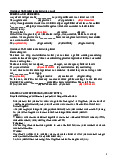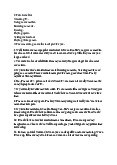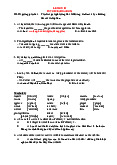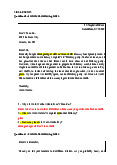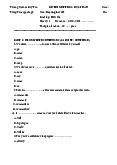








Preview text:
REVISION READING LEVEL 2
1. Reading passages from Unit 1 to Unit 9 in WORKBOOK AND STUDENT’S BOOK 2. EXTRA READING:
I. READING PASSAGE 1: The life of the European bee-eater
A brilliant movement of colour as it catches its food in the air, the European bee-eater moves
between three continents.
True to their name, bee-eaters eat bees (though their diet includes just about any flying insect).
When the bird catches a bee, it returns to its tree to get rid of the bee's poison, which it does very
efficiently. It hits the insect's head on one side of the branch, then rubs its body on the other. The
rubbing makes its prey harmless.
European bee-eaters (Merops apiaster) form families that breed in the spring and summer across
an area that extends from Spain to Kazakhstan. Farmland and river valleys provide huge
numbers of insects. Flocks of bee-eaters follow tractors as they work fields. When the birds
come upon a beehive, they eat well - a researcher once found a hundred bees in the stomach of a bee-eater near a hive.
European bees pass the winter by sleeping in their hives, which cuts off the bee-eater's main
source of food. So, in late summer, bee-eaters begin a long, dangerous journey.
Massive flocks from Spain, France and northern Italy cross the Sahara Desert to their wintering
grounds in West Africa. Bee-eaters from Hungary and other parts of Central and Eastern Europe
cross the Mediterranean Sea and Arabian Desert to winter in southern Africa. 'It's an extremely
risky stratagem, this migration, says C. Hilary Fry, a British ornithologist who has studied
European bee-eaters for more than 45 years. ‘At least 30 percent of the birds will be killed by
predators before they make it back to Europe the following spring.’
In April, they return to Europe. Birds build nests by digging tunnels in riverbanks.
They work for up to 20 days. By the end of the job, they've moved 15 to 26 pounds of soil - more than 80 times their weight.
The nesting season is a time when families help each other, and sons or uncles help feed their
father's or brother's chicks as soon as they come out of their eggs. The helpers benefit, too:
parents with helpers can provide more food for chicks to continue the family line.
It's a short, spectacular life. European bee-eaters live for five to six years. The difficulties of
migration and avoiding predators along the way affect every bird. Bee-eaters today also find it
harder to find food, as there are fewer insects around as a result of pesticides. Breeding sites are
also disappearing, as rivers are turned into concrete-walled canals.
Questions 1-8: write NO MORE THAN TWO WORDS form the passage for each answer
1. Bee-eaters’ prey are bees and other ………………
2. Bee-eaters need to remove the ……….……. from bees before eating them.
3. There is plenty of food for bee-eaters on agricultural land and in ……………
4. Bee-eaters migrate to spend the winter in different parts of ……………….
5. Because of ………………, almost one-third of bee-eaters do not survive migration.
6. Bee-eaters make nests in ………………….., which they build themselves.
7. When nesting, the …………………….. receive food from different family members.
8. One problem for bee-eaters is …………………….., which have reduced the amount of food available
II. READING PASSAGE 2: Pedestrians only
How traffic-free shopping streets developed
i. The concept of traffic-free shopping areas goes back a long time. During the Middle
Ages, traffic-free shopping areas known as souks were built in Middle Eastern countries to allow
people to shop in comfort and, more importantly, safety. As far back as 2,000 years ago, road
traffic was banned from central Rome during the day to allow for the free movement of pedestrians,
and was only allowed in at night when shops and markets had closed for the day. In most other
cities, however, pedestrians were forced to share the streets with horses, coaches and, later, with
cars and other motorised vehicles.
ii. The modern, traffic-free shopping street was born in Europe in the 1960s, when both
city populations and car ownership increased rapidly. Dirty exhaust fumes from cars and the risks
involved in crossing the road were beginning to make shopping an unpleasant and dangerous
experience. Many believed the time was right for experimenting with car-free streets, and shopping
areas seemed the best place to start.
iii. At first, there was resistance from shopkeepers. They believed that such a move would
be bad for business. They argued that people would avoid streets if they were unable to get to them
in their cars. When the first streets in Europe were closed to traffic, there were even noisy
demonstrations, as many shopkeepers predicted they would lose customers.
iv. However, research carried out afterwards in several European cities revealed some
unexpected statistics. In Munich, Cologne and Hamburg, visitors to shopping areas increased by
50 percent. On Copenhagen's main shopping street, shopkeepers reported sales increases of 25-40
percent. Shopkeepers in Minneapolis, USA, were so impressed when they learnt this that they even
offered to pay for the construction and maintenance costs of their own traffic-free streets
v. With the arrival of the traffic-free shopping street, many shops, especially those selling
things like clothes, food and smaller luxury items, prospered. Unfortunately, it wasn’t good news
for everyone, as shops selling furniture and larger electrical appliances actually saw their sales
drop. Many of these were forced to move elsewhere, away from the city centre. Today they are a
common feature on the outskirts of towns and cities, often situated in out-of-town retail zones with
their own car parks and other local facilities.
QUESTIONS 9-14: Match the headings below with paragraphs
i – v in the reading passage 9. Facing local opposition ………………… 10. Winners and losers …….………. 11. A need for change …………………
12. An experiment that went wrong …………………
13. An idea from ancient history …………...........
14. North America learns from Europe …………............
III. READING PASSAGE 3: Marcel Bich
The man who turned a luxury item into an everyday object
Marcel Bich, a French manufacturer of traditional ink pens, was the man who turned the
ballpoint pen into an item that today almost anyone can afford. Bich was appall t the poor quality
of the ballpoint pens that were available, and was also shocked at their high cost. However, he
recognised that the ballpoint was a firmly established invention, and he decided to design a cheap
pen that worked well and would be commercially successful.
Bich went to the Biro brothers and asked them if he could use the design of their original
invention in one of his own pens. In return, he offered to pay them everv time he sold a pen.
Then, for two years, Bich studied the detailed construction of every ballpoint pen that was being
sold, often working with a microscope.
By 1950, he was ready to introduce his new wonder: a plastic pen with a clear barrel that
wrote smoothly, did not leak and only cost a few cents. He called it the 'Bic Cristal'. The
ballpoint pen had finally become a practical writing instrument. The public liked it immediately,
and today it is as common as the pencil. In Britain, they are still called Biros, and many Bic
models also say 'Biro' on the side of the pen, to remind people of their original inventors.
Bich became extremely wealthy thanks to his invention, which had worldwide appeal.
Over the next 60 years his company, société Bic, opened factories all over the world and
expanded its range of inexpensive products. Today, Bic is as famous for its lighters and razors as
it is for its pens, and you can even buy a Bic mobile phone. Questions 15-22: NO MORE THAN TWO WORDS Choose
from the passage for each answer
It is thanks to Marcel Bich that most people today are able to ……………………… 1 a ballpoint
pen. It was the bad quality and ……………………….. 2
of the pens which were available at the
time that inspired him to design a ………………………… 3
ballpoint pen that would be both
inexpensive and reliable. After getting permission from the Biro brothers to base his pen on their
4 ………………………, he carefully ………………………. 5
Other ballpoints that were sold in
the shops, and in 1950 introduced his own version, the ‘bic Cristal’. It was popular with the
6…………………, and Bich became very rich. His company, Bic, now makes a variety of cheap
7 ………………….., such as lighters and razors. IV.
READING PASSAGE 4: On the trail of the honey badger
Researchers learn more about this fearless African predator
On a recent field trip to the Kalahari Desert, a team of researchers learnt a lot more about honey
badgers. They were rewarded with a detailed insight into how these fascinating creatures live and hunt.
The team employed a local wildlife expert, Kitso Khama, to help them locate and follow the
badgers across the desert. Their main aim was to study the badgers' movements and behaviour as
discreetly as possible, without frightening them away or causing them to change their natural
behaviour. They also planned to trap a few and study them close up before releasing them. In view
of the animal's reputation, this was something that even Khama was reluctant to do.
The problem with honey badgers is they are naturally curious animals, especially when they see
something new, he says. "That, combined with their unpredictable nature, can be a dangerous
mixture. If they sense you have food, for example, they won't be shy about coming right up to you
for something to eat. They're actually quite sociable creatures around humans, but as soon as they
feel they might be in danger, they can become extremely vicious. Fortunately, this is rare, but it does happen.
The research confirmed many things that were already known. As expected, honey badgers ate
any creatures they could catch and kill.
Even poisonous snakes, feared and avoided by most other animals, were not safe from them. The
researchers were surprised, however, by the animal's fondness for local melons, probably because
of their high water content. Previously researchers thought that the animal got all of its liquid
requirements from its prey. The team also learnt that, contrary to previous research findings, the
badgers occasionally formed loose family groups. They were also able to confirm certain results
from previous research, including the fact that female badgers never socialised with each other.
Following some of the male badgers was a challenge, since they can cover large distances in a
short space of time. Some hunting territories cover more than 500 square kilometres. Although
they seem happy to share these territories with other males, there are occasional fights over an
important food source, and male badgers can be as aggressive towards each other as they are towards other species.
As the badgers became accustomed to the presence of people, it gave the team the chance to get
up close to them without being the subject of the animals' curiosity - or their sudden aggression.
The badgers' eating patterns, which had been disrupted, returned to normal. It also allowed the
team to observe more closely some of the other creatures that form working associations with the
honey badger, as these seemed to adopt the badgers' relaxed attitude when near humans.
Questions 2-5: Read the rest of the passage and choose TWO letters, A-E,
2. What are two things does Kitso Khama say about honey badgers?
A. They show interest in things they are not familiar with.
B. It’s hard to tell how they will behave.
C. They are always looking for food.
D. They do not enjoy human company.
E. It is common for them to attack people.
3. What are two things did the team find out about honey badgers?
A. There are some creatures they will not eat.
B. They were afraid of poisonous creatures.
C. They may get some of the water they need from fruit.
D. They do not always live alone.
E. Female badgers do not mix with male badgers.
4. According to the passage, which of these two features are typical of male badgers?
A. They don’t run very quickly.
B. They hunt over a very large area.
C. They defend their territory from other badgers.
D. They sometimes fight each other.
E. They are more aggressive than females.
5. What two things happened when the honey badgers got used to humans being around them?
A. The badgers lost interest in people.
B. The badgers became less aggressive towards other creatures.
C. The badgers started eating more.
D. Other animals started working with the badgers.
E. Other animals near them became more relaxed. V.
READING PASSAGE 5: Matching headings; Sentence completion and Pick from a list The rain makers
A. Wheat farmer Gang Liu is a worried man. The annual rains have not arrived, and there is a
danger that unless there is substantial rainfall soon, his annual wheat crop will fail. As he looks
anxiously at the clouds which promise rain but are failing to anxiously it, there is a sudden loud
roar, and from fields for miles around, hundreds of small rockets are fired into the clouds. Within
twenty minutes, the farms around the eastern Chinese city of Luohe are experiencing their first
rain for many weeks. Gang Liu's valuable wheat has been saved, thanks to a technique known as
'cloud seeding', in which the chemical silver iodide (Agl) is introduced into clouds. This causes
the tiny drops of moisture in the clouds to turn to ice. These tiny ice particles join until they become
heavy enough to fall from the sky, turning into rain as they melt.
B. But did cloud seeding really cause the rain in Luohe to fall, or was it just a coincidence?
Experts often question whether cloud seeding actually works. It is hard to tell how effective cloud
seeding actually is, they say, as it might have rained anyway, without human intervention. But this
has not stopped many governments and organisations from trying. There are currently 150
weather-modifying projects taking place in more than 40 countries. Not all of them are aimed at
creating rain. The Eastlund Scientific Enterprises Corporation in the USA, for example, is
experimenting with firing microwaves into clouds to prevent the tornadoes which cause enormous
damage to the country every year. In Russia, experiments have been carried out to make sure the
sun shines during important national events.
C. However, it is rainmaking that dominates the research programmes. In many of these,
researchers are using trials in which some clouds are 'seeded' while others are not, and both groups
are monitored. Arlen Huggins of the Desert Research Institute is leading a research project in
Australia. Weather-monitoring technology is so good nowadays, he says, that we can measure
clouds much more effectively, even from the inside. As a result, we now know much more about
the effect humans can have on the weather. What Huggins' team has discovered so far is promising.
They believe that cloud seeding does work, although there are still two years of the six-year project left to go.
D. In China, where the majority of cloud-seeding operations take place, weather-modification
authorities use army rockets to fire silver-iodide particles into the clouds. 39,000 staff working for
the China Meteorological Administration (CMA) are equipped with 7,113 army cannons which,
in 2006, were used to fire a million silver-iodide rockets into the atmosphere. This costs over $100
million a year, although the CMA claims the results are worth the expense. Between 1999 and
2006, they say, cloud seeding produced 250 billion metric tonnes of rain and prevented thousands
of farmers from losing their crops.
E. "We want to understand what makes clouds rain," says Philip Brown of the UK
Meteorological office, explaining why so much time, effort and money are being invested. "But
there is a more powerful economic reason. A lot of countries around the world are at risk from
drought, and governments will try anything to make sure that doesn't happen, even if the scientific
evidence is weak. The potential economic value is greater than the scientific value. Making it rain
might allow you to keep agriculture going where, without human intervention, it might fail."
F. Some people are concerned, however, that altering the weather can have negative
consequences. Leonard Barrie, director of the research department at the World Meteorological
Organisation in Geneva, explains why. "All areas of weather modification are still very
controversial. Some people think that diverting water for irrigation benefits some people, but is a
disadvantage to others. Someone in one area will get more water, but as a result, someone
somewhere else could get less." His fears may be justified. Recently, the town of Zhoukou in
China's Henan province accused neighbouring town Pingdingshang of 'stealing' rain from clouds
that were due to pass over its own farms, prompting what may be the world's very first documented incident of 'rain rage'.
1. Questions 1 – 6: Matching Headings
The reading passage has six paragraphs, A-F. Choose the correct heading for each paragraph
from the list of headings below. 1. Paragraph A…………. 2. Paragraph B ………… 3. Paragraph C …………. 4. Paragraph D …………. 5. Paragraph E …………. 6. Paragraph F ………
2. Questions 7 – 12: Sentence Completion Complete the sentences below.
Choose NO MORE THAN ONE WORD AND/OR A NUMBER from the passage for each answer.
7. Experts are unsure if cloud seeding is ……………… or not.
8. At the moment, there are over ……………… where projects are being carried out to modify the weather.
9. Thanks to modern ………………, it is now possible to get better results when clouds are monitored.
10. The Desert Research Institute project will finish in a couple of ………………
11. The CMA gets the equipment they need from the ………………
12. A large number of ………………benefited from cloud seeding carried out by the CMA.
3. Questions 13 – 14: Pick from the list
Choose TWO letters, A-E.
Which TWO of these sentences are true about cloud seeding, according to the passage? 13………. 14………..
A. China carries out more cloud seeding than anywhere else.
B. Cloud seeding is too expensive for most countries.
C. Cloud seeding is mostly done for scientific rather than economic reasons.
D. Cloud seeding helps turn dry areas of land into agricultural areas.
E. Cloud seeding may affect the distribution of rainfall READING PASSAGE 6:
What is the secret of a long life?
This year, the number of retired pensioners in the UK exceeded the number of under 18 years old
for the first time in history. That's remarkable in its own right, but the real 'population explosion'
has been among the oldest of the old — the centenarians. In fact, this imbalance is the fastest
growing demographic in much of the developed world. In the UK, the number of centenarians
has increased by 60 per cent since the early 20th century. And their ranks are set swell even
further, thanks to the ageing baby-boomer generation: by 2030 there will be about a million worldwide.
These trends raise social, ethical and economic dilemmas. Are medical advances artificially
prolonging life, with hide regard for the quality of that life? If growing numbers of elderly
people become dependent on state or familial support, society faces skyrocketing costs and
commitments. Yet researchers who study the oldest old have made a surprising discovery that
presents a less pessimistic view of the future than many anticipate.
It is becoming clear that people who break through the 90-plus barrier represent a physical elite.
Far from gaining a longer burden of disability, their extra years tend to be healthy ones. And
supercentenarians, people aged 110 or over, are even better examples of ageing well. The
average supercentenarian had freely gone about their daily life up until the age of 105 or so,
some five to ten years longer even than centenarians.
One of the most comprehensive studies comes from Denmark. In 1998 Kare Christensen, at the
University of Southern Denmark, contacted every single one of 3600 people born in 1905 who
was still alive. Assessing their health over the subsequent decade, he found that the proportion of
people who managed to remain independent throughout was constantly around one-third of the
total. Each individual risked becoming more infirm, but the unhealthiest ones passed away at
earlier ages, leaving the strongest behind. In 2005, only 166 of the people in Christensen's
sample were still alive, but one-third of those were still entirely self-sufficient.
Christensen's optimistic findings are echoed in studies all over the world. In the MC, Carol
Brayne at the University of Cambridge studied 958 people aged over 90, and found that only
one-quarter of them were living in accommodation specifically catering for the needs of older
people. Research in China reveals that centenarians and nonagenarians spend fewer days ill and
in bed than younger elderly groups. Of course, people can live independently without being
entirely healthy, and it is true that most centenarians suffer from some kind of ailment. These
range from osteoarthritis to simple loneliness.
Not all the oldest old survive by delaying illness or disability, though. Many soldier through it.
Jessica Even of Ohio State University examined the medical histories of over 400 centenarians.
She found that those who achieve extreme longevity tend to fall into three categories. About 40
per cent were 'delayers', who avoided chronic diseases until after the age of 80. Another 40 per
cent were 'survivors', who suffered from chronic diseases before the age of 80 but lived longer to
tell the tale. The final 20 per cent were 'escapers', who reached their century with no sign of the
most common chronic diseases. Intriguingly, one- third of male centenarians were in this
category, compared with only 15 per cent of women. In fact, the two sexes fare very differently
when it comes to longevity. There are far more female centenarians, but the reasons for this are
unclear. Certainly, women tend to lead healthier lifestyles and experience fewer serious
accidents. They also go to their doctor more. Men are more prone to risky behaviour and chronic
illness, so it must be genetics which allows some men to reach extreme old age. Evidence of this
comes from longevity hotspots.
The Japanese island of Okinawa is the front runner. At 58 centenarians per 100,000 people, it has
the world's highest proportion in this age group, with Sardinia and Iceland not too far behind. All
three are relatively isolated island communities, which leads to less genetic variation amongst
inhabitants. In these places, the result has been a predisposition towards a longer life. Of
course, members of such communities usually share a particular environment, too, but this alone
cannot explain longevity. Gerontologists have emphasised the importance of regular exercise, so
anyone aiming to reach a century should not underestimate this. They have also found that the
influence on lifespan of social factors such as wealth fades as we age. By comparing 10,000 pairs
of Scandinavian twins, Christensen found that genes are key, but that they only start exerting a
strong influence on our lifespan after the age of 60. Before then, those who are both identical and
nonidentical have largely independent chances of reaching a given age.
Longevity genes have also been found in abundance in other organisms, including over 70 in
particular worms. Unfortunately, it's a different story in humans. While many genes have been
suggested to affect lifespan, very few have been consistently verified in multiple populations. Note:
1 .’’Centenarian”: someone who is 100 years or older.
2. ” Baby - boomer“: someone born just after the Second World War, a time which saw a rapid increase in birth rate.
3. “Nonagenarian”: someone who is between 90 and 99 years old.
4. “Gerontologist”: a medical professional who specialises in aging and the problems of aged Persons. READING PASSAGE 7: PRIVATE SCHOOLS
Most countries’ education systems have had what you might call educational disasters, but, sadly,
in many areas of certain countries these ‘disasters’ are still evident today. The English education
system is unique due to the fact that there are still dozens of schools which are known as private
schools and they perpetuate privilege and social division. Most countries have some private
schools for the children of the wealthy; England is able to more than triple the average number
globally. England has around 3,000 private schools and just under half a million children are
educated at them whilst some nine million children are educated at state schools. The
overwhelming majority of students at private schools also come from middle-class families.
The result of this system is evident and it has much English history embedded within it. The facts
seem to speak for themselves. In the private system almost half the students go on to University,
whilst in the state system only about eight per cent make it to further education. However, statistics
such as these can be deceptive due to the fact that middle-class children do better at examinations
than working class ones, and most of them stay on at school after 16. Private schools therefore
have the advantage over state schools as they are entirely ‘middle class’, and this creates an
environment of success where students work harder and apply themselves more diligently to their school work.
Private schools are extortionately expensive, being as much as £18,000 a year at somewhere such
as Harrow or Eton, where Princes William and Harry attended, and at least £8,000 a year almost
everywhere else. There are many parents who are not wealthy or even comfortably off but are
willing to sacrifice a great deal in the cause of their children’s schooling. It baffles many people as
to why they need to spend such vast amounts when there are perfectly acceptable state schools that
don’t cost a penny. One father gave his reasoning for sending his son to a private school, ‘If my
son gets a five- percent-better chance of going to University then that may be the difference
between success and failure.” It would seem to the average person that a £50,000 minimum total
cost of second level education is a lot to pay for a five-percent-better chance. Most children, given
the choice, would take the money and spend it on more enjoyable things rather than shelling it out
on a school that is too posh for its own good
However, some say that the real reason that parents fork out the cash is prejudice: they don’t want
their little kids mixing with the “workers”, or picking up an undesirable accent. In addition to this,
it wouldn’t do if at the next dinner party all the guests were boasting about sending their kids to
the same place where the son of the third cousin of Prince Charles is going, and you say your kid
is going to the state school down the road, even if you could pocket the money for yourself instead,
and, as a result, be able to serve the best Champagne with the smoked salmon and duck.
It is a fact, however, that at many of the best private schools, your money buys you something.
One school, with 500 pupils, has 11 science laboratories; another school with 800 pupils, has 30
music practice rooms; another has 16 squash courts, and yet another has its own beach. Private
schools spend £300 per pupil a year on investment in buildings and facilities; the state system
spends less than £50. On books, the ratio is 3 to 1.
One of the things that your money buys which is difficult to quantify is the appearance of the
school, the way it looks. Most private schools that you will find are set in beautiful, well-
Access http://mini-ielts.com for more practices 1
kept country houses, with extensive grounds and gardens. In comparison with the state schools,
they tend to look like castles, with the worst of the state schools looking like public lavatories,
perhaps even tiled or covered in graffiti. Many may even have an architectural design that is just
about on the level of an industrial shed.
